Choosing the Right Sales Structure
 In today’s complex world of sales where customer buying behavior is becoming increasingly sophisticated, sales leaders are being forced to transform how they approach managing their sales organizations in order to achieve desired business results. One of the many challenging tasks these leaders face is allocating resources across geographies to meet evolving business and customer needs.
In today’s complex world of sales where customer buying behavior is becoming increasingly sophisticated, sales leaders are being forced to transform how they approach managing their sales organizations in order to achieve desired business results. One of the many challenging tasks these leaders face is allocating resources across geographies to meet evolving business and customer needs.
Done right, a well-designed sales organization structure can help reduce costs, drive efficiencies, and increase customer loyalty. But in the current sales environment, the right answer is often a moving target as various sales structures have their own set of advantages and disadvantages. Therefore it’s no surprise that making such a decision is far from easy.
To help make these decisions easier for sales leaders, SEC benchmarked the sales organizational structures of member companies across industries and geographies to assess how the best companies are approaching this challenge. Though we observed a series of interesting trends during this initiative, one of the most important things we learned is that the best companies assess the trade-offs involved in implementing different sales structures to achieve desired results. When selecting an organizational structure, SEC finds that the choice boils down to one of the following consideration sets:
Product vs. Geography vs. Customer-Focused Structure: Sales organizations have traditionally built their structure to map company offerings or regions served. That said, rising buyer sophistication coupled with growing requirements to build consensus in the customer organization is driving the need to be more customer-focused. In particular, the key benefit of a geography- or product-focused structure—deep expertise of reps—is eroding as customers become smarter and complete a lot of the due diligence on their own, rather than engaging suppliers to do this.
Centralized vs. Decentralized vs. Matrix Structure: The choice between centralized and decentralized structures was an either/or choice until the arrival of matrix structures that brought the best of both worlds. Specifically, it allowed companies to operate in a truly global environment, yet at the same time maintain their regional responsiveness. That said, adoption of matrix structures has been slow given the added complexity it brings to the management of resources, with many sales organizations choosing to remain centralized or decentralized in structure.
Vertical vs. Horizontal Structure: The emphasis on vertical (or functional) and horizontal (or business process) orientation of the sales organization is based on the relative importance of cross-functional coordination of activities for the achievement of customer and business goals. The choice of structure ultimately establishes the primary grouping of work-processes, skills, and knowledge used to drive sales. That said, many companies find a carefully balanced combination of the two structures yields greatest success.
Has your sales organization restructured recently or do you plan to restructure soon? What changes have you seen or hope to see as a part of restructuring?
SEC Members, to learn more about the organizing principles, the benefits and drawbacks, and the best fit characteristics of each of these structures, make sure to visit our new resource center on how to Design an Effective Organizational Structure.
Brent Adamson's Blog
- Brent Adamson's profile
- 9 followers



